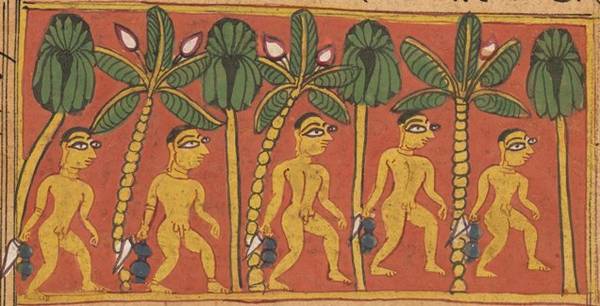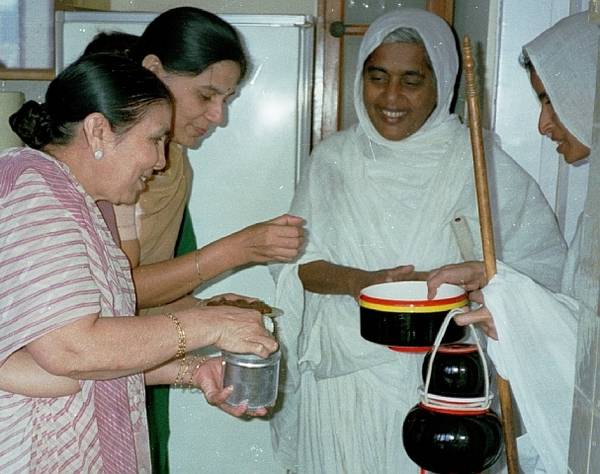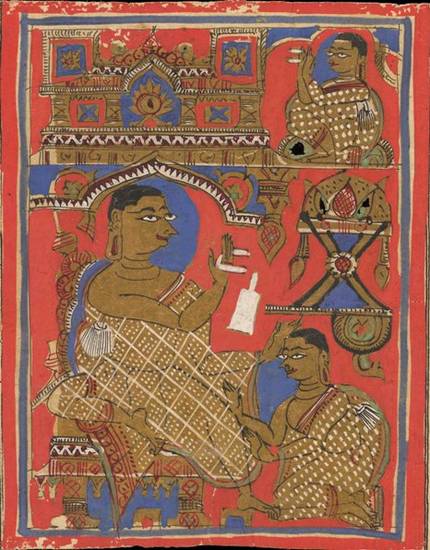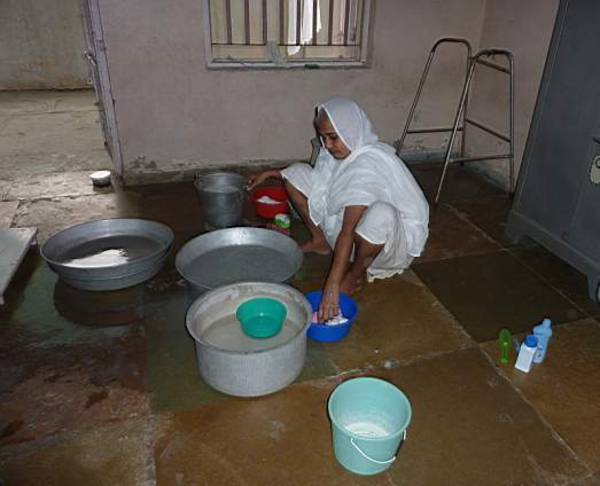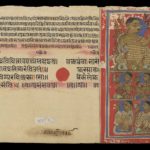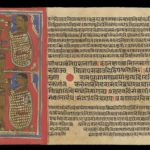Article: Mendicant lifestyle
The term ‘mendicant’ refers to monks and nuns in general. Jain mendicants are people who have become monks or nuns after the official initiation ceremony called dīkṣā. They renounce ordinary life, receive the monastic equipment in accordance with the monastic order to which they will belong.
After that they lead a life conforming to the ‘five great vows’ – mahā-vrata. These vows provide a frame of behaviour for mendicants, but there are many specific rules for each and every aspect of daily life.
Different terms for mendicants
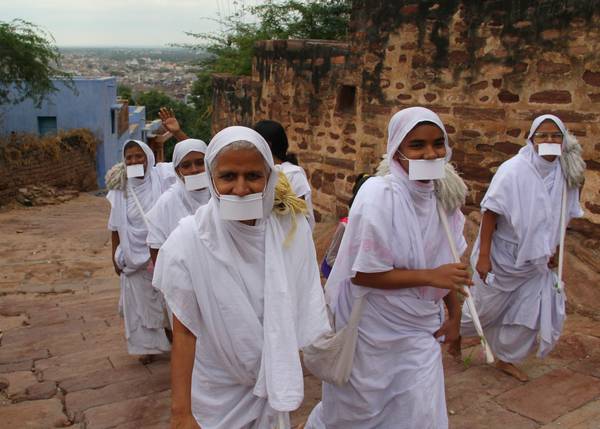
Śvetāmbara Sthānaka-vāsin or Terā-panthin nuns
Image by arjunstc – Arjun © CC BY-NC-ND 3.0
Depending on the period and sources, there is a wide range of terms for Jain ascetics, most referring to various aspects of their lives.
The two main sects of the Digambaras and Śvetāmbaras normally use slightly different words for their monks and nuns.
Early Jain writings
Early records that mention mendicants call them by different expressions according to the context. There is a masculine and feminine form of each term.
|
Meaning |
Men |
Women |
|---|---|---|
|
mendicant as a spiritual person – ‘without knot, without bond’ |
niggantha |
nigganthī |
|
mendicant as someone begging alms |
bhikkhu |
bhikkuṇī |
|
mendicant as a person who practises asceticism and penance |
samaṇa |
samaṇī |
|
general term for a sage |
Other contexts
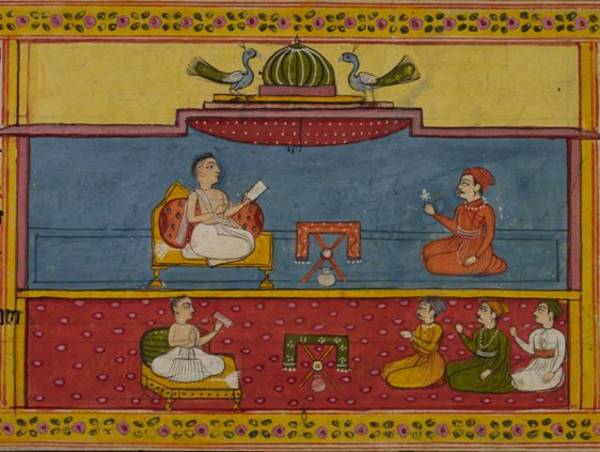
Lay men listen to monks
Image by British Library © CC0 1.0 (Creative Commons Public Domain)
Intermediate categories
Each sect also has special types of mendicant.
|
Meaning |
Men |
Women |
|---|---|---|
|
‘junior’ – a state between an ordinary lay follower and a full-fledged mendicant |
kṣullikā |
|
|
position higher than that of a kṣullaka because it entails stricter vows |
ailaka |
|
Meaning |
Men |
Women |
|---|---|---|
|
one who lives a sedentary life and does not take the full vows |
||
|
special category among the Śvetāmbara Terā-panthin sect |
samaṇa |
samaṇī |
The samaṇa and samaṇī have fewer restrictions than full mendicants. For example, they can use transport instead of only walking.
Wandering and sedentary life
Monastic life depends on the season. The year is divided into two parts, consisting of the:
- four months of the rainy season
- eight remaining months.
|
Season |
Activity |
|---|---|
|
eight months of the year |
wandering life – known as vihāra in modern times |
|
rainy season – about four months |
living in the same place without travelling |
Wandering life
As part of the mendicant lifestyle, Jain monks and nuns are expected to travel around, not stay in one place as householders do. Known as vihāra, ‘wandering’ means walking along the roads from one place to another one, starting very early in the morning. The distances vary, but they can amount to 20 to 30 kilometres a day. Being a Jain ascetic therefore requires physical strength and resilience.
The destination is decided by a leading mendicant of a small group, or by the head of the monastic order in the case of the Terāpanthins. During the ceremony known as māryādā-mahotsava, he decides where the various groups of ascetics should go for the next rainy season. They reach their destinations in stages. Ascetics wander in groups of varying sizes. A mendicant is generally not expected to be alone.
According to traditional rules, mendicants are not allowed to stay more than a few days in the same place outside the rainy season. This rule is still in force today, although the duration of their stay may be longer. In extreme cases, the mendicants would always stay in the same place.
Life in the rainy season
Called caturmāsa in Sanskrit and comāsa in Gujarati, the rainy season lasts from June or July up to October or November each year.
The rainy season is traditionally considered unsuitable for wandering for three main reasons. Mendicants traditionally only go on foot and for the practical reasons of floods, muddy roads and so on travelling is very difficult during this period. It is also a time when numerous minute beings are born because of the combined warmth and humidity. Hence it is believed that hurting living beings is much easier, which makes it easier to accidentally break the fundamental Jain principle of non-violence. Limiting one’s movements is a way to counteract this risk. Finally, staying in one place enables mendicants to meet the local lay communities daily, through preaching, begging alms and so on. Thus lay people are more inclined to study or to keep additional dietary restrictions and so on.
Daily activities
Jain ascetics do various things each day, ranging from seeking alms to performing the six rituals of a mendicant. They may also have other religious duties, although customs vary in the different sects and monastic orders.
Gathering alms
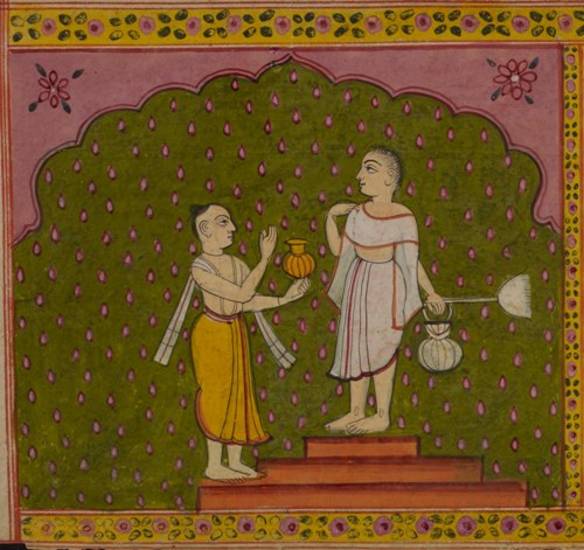
Monk receives alms
Image by British Library © CC0 1.0 (Creative Commons Public Domain)
Jain mendicants are not allowed to cook food themselves. They are also not allowed to get it cooked by anybody in the premises where they stay. Thus they have to go to lay people’s houses to get food.
The begging tour takes place twice a day for Śvetāmbara mendicants – once in the morning, and once in the afternoon. Digambara ascetics seek alms once a day. Finding correctly offered alms that are suitable may take hours. However, all food has to be eaten before sunset.
Six daily obligatory rituals
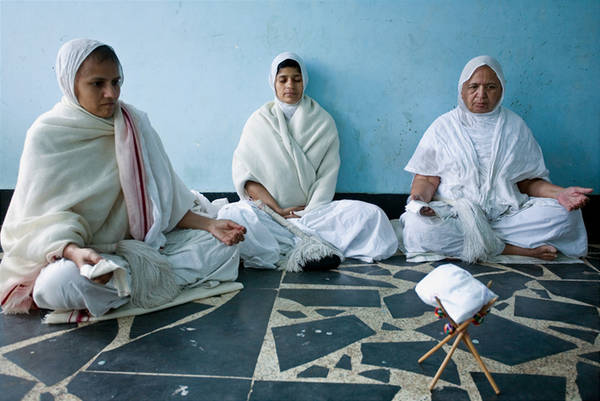
Śvetāmbara nuns meditate
Image by Claude Renault © CC BY 2.0
The six rituals each mendicant is obliged to complete every day are known as āvaśyaka – ‘necessary, required’:
- serenity – sāmāyika
- praise of the 24 Jinas
- offering worship and respect towards mendicants
- repentance – pratikramaṇa
- rejection of the body – kāyotsarga
- vowing special austerities for the future.
The most important is the ritual of repentance – pratikramaṇa – which takes place at regular periods, at least twice a day.
Other activities
Mendicants usually do other things during the day. What they do depends on the monastic order, the place of an ascetic within this order, the sex of the mendicant, age and other factors.
Studying
Ascetics may read and study the scriptures or other subjects, such as grammar, poetry and philosophy. Whether they do this very much depends on the monastic order to which they belong.
Some monastic orders support it for all ascetics while others do not encourage it for nuns. Yet others make a point of promoting female mendicants’ education.
Writing and copying
Mendicants do not necessarily write and copy texts. This activity is connected with monastic education, which depends on the individual mendicant order. Writing in minute script or copying are almost artistic activities.
Recitation and singing
Learning by heart is an important activity for monks and nuns, even today.
All activities that favour memorisation are encouraged but using electricity or even a lamp is not allowed. Memorising keeps the mind busy even in these conditions.
Public preaching
Consultation
It is common to see lay people visiting the mendicants’ lodgings – upāśraya – to talk with them, to receive their blessing or advice on worldly matters. These can be thought of as consultations, but lay newcomers can come along so these meetings are not private.
The mendicants often answer queries by talking about a more general belief or principle and like to refer to past or present examples, role models, and so on. These are very numerous in Jain story literature.
Manual activities
Like everyone else, Jain mendicants must attend to practical necessities, such as washing monastic robes. Related to this are more artistic activities such as stitching and embroidering. These tasks are done mostly by nuns or junior mendicants.
Sleep
Jain monks and nuns generally sleep only for a few hours at night, around three to five hours.
Mendicant hierarchy
The mendicant groups are organised in ranks based on seniority, sex and position. Seniority is based on the number of years spent as a mendicant since religious initiation – dīkṣā – not on the real age of the person.
General principles of this hierarchy are:
- juniors serve and respect senior ascetics
- a mendicant who holds an official position is senior to one who does not
- a monk is always senior to a nun, irrespective of mendicant age or office held.
The titles of the various roles vary among the different monastic orders and they have varied in the course of history. The names found in earlier texts are not necessarily the same as those used today. Among the Śvetāmbaras, sūri and gacchā-dhipati are the highest titles. Among the Digambaras, it is muni and ācārya.
Promotion to higher positions is an occasion for ceremonies and celebrations organised by the lay communities. Promotion comes through appointment from older mendicants or from the head of the sect, if there is one. The various positions take into account the achievements of the mendicants. For example,a preceptor or tutor – upādhyāya – or a pannyāsa – approximately ‘learned’ – are those who have been recognised as having a special proficiency in the knowledge of scriptures.
Attitudes towards modern life
The development of modern technologies is a challenge for today’s Jain mendicants. The great majority of them keep to traditional rules, which means that:
- they do not use any means of transportation and only walk
- they do not use electricity because it is considered a form of fire, and its use endangers fire-beings
- they do not use modern toilets
- they do not accept modern medicine, especially surgery.
There are, however, some exceptions. These are of two kinds – institutional and individual.
Institutional exceptions are the mendicants in the intermediate category of samaṇ and samaṇis among the Śvetāmbara Terā-panthins. In particular, they are allowed to use methods of transportation and travel abroad. They play an important role for the Jain diaspora outside India.
Individual exceptions include leading mendicants in various groups who believe that they have to adjust to changing contexts and make use of modern innovations for the sake of their religion’s future. Such decisions often give rise to heated discussions and criticisms. One example is that of the three brothers known as ‘Bandhu Triputi’. These three men are Śvetāmbara Mūrti pūjaka monks who travel extensively to Europe and America and do not consider that this amounts to breaking the rule.
Reading
- ‘The Śvetāmbara Mūrtipūjak Jain Mendicant’
John Cort - Man (New Series)
volume 29: 4
Royal Anthropological Institute of Great Britain and Ireland; 1991
- ‘The Codes of Conduct of the Terāpanth Samaṇ Order’
Peter Flügel - South Asia Research
volume 23: 1
SAGE Publications; 2003
- Guardians of the Transcendent: An Ethnography of a Jain Ascetic Community
Anne Vallely - University of Toronto Press; Toronto, Canada; 2002
- Riches and Renunciation: Religion, Economy and Society among the Jains
James Laidlaw - Oxford Studies in Social and Cultural Anthropology series
Oxford University Press; Oxford, UK; 1995
- Escaping the World: Women Renouncers among Jains
Manisha Sethi - South Asian History & Culture series; volume 8
Routledge Taylor & Francis Group; London, UK and New Delhi, India; 2011
Links
- Mahāvīr Jayantī procession – part one
-
The festival of Mahāvīr Jayantī is often marked with a procession in which images of the 24th Jina Mahāvīra are carried through the streets. This large procession is made up of animals, singers and musicians, dancers and local Jains celebrating the birth of the last Jina. This procession took place in March 2010 in Jaipur, Rajasthan and also featured the message of environmental conservation.
Captured in two parts on YouTube, this is the first part. You can also watch the second part.
- Two Śvetāmbara Terāpanthin samaṇī nuns
-
This YouTube video dating from 2009 shows two Śvetāmbara Terāpanthin samaṇīs tallking about their religious background and beliefs. They hold folded cloths in front of their mouths while they speak. Normally Śvetāmbara Terāpanthin monks and nuns wear a mouthcloth – muṃhpatti – permanently over their mouths, hanging from strings over the ears. Samaṇīs have important roles in teaching the Jain diaspora.
- Hymn to Naminātha
-
This 2007 hymn on YouTube is a Sanskrit stotra to the 21st Jina, Naminātha or Lord Nami. The sound is accompanied by pictures of statues of Jinas and monks of various Jain sects. The plain statues of nude Jinas with closed eyes and the naked monks belong to Digambara sects. The white-robed mendicants are Śvetāmbara Mūrtipūjakas. The monks and nuns with mouth-cloths attached to their ears are from either the Terāpanthin or Sthānaka-vāsīn Śvetāmbara sects.
- Śruta-pañcamī – part 2
-
The procession of holy texts in the annual Digambara festival of knowledge – Śruta-pañcamī – is the main subject of this YouTube video. As the centre of festivities, the sacred books are decorated with flower garlands. They are placed on a model elephant, protected from the sun by a canopy and fanned with fly-whisks, all symbols of royalty. The Jain flag is waved in front. Lay Jains, many dressed in orange – the colour of spirituality in India – take part in the noisy procession. Some carry the metal sculptures of the 12 dreams of a Jina’s birth. A nude monk, holding his peacock-feather broom, and white-clad nuns also participate. The procession ends with a display of holy books, the reflection of which is ritually anointed, and a rite of worship in which the auspicious symbol of the svastika can be clearly seen.
This three-part YouTube video records the festival at Mudalur, Tamil Nadu in India, held over 28th and 29th May 2009. This is the second part and you can watch the last part at: http://www.youtube.com/watch?v=zR21K-vcp5U
- Nineteenth-century Jains at prayer
-
Attributed to LaPlante, an engraving entitled 'Religious Service of the Jains, Bombay', published in the Illustrated London News in 1875. A monk is shown sitting in the lotus position with a bookstand to his right. The lay Jains sit on the floor to hear his sermon.
From the collection of Professor Frances W. Pritchett of Columbia University in New York.
- Five Great Monastic Vows
-
Pravin K. Shah writes about the Five Great Vows taken by Jain monks and nuns. The information is provided by the Jainism Literature Center, associated with the Faculty of Arts and Sciences at Harvard University.
http://www.fas.harvard.edu/~pluralsm/affiliates/jainism/jainedu/5greatvows.htm
- Procession of Mahāvīra idol
-
This 2009 YouTube video shows the procession of a small golden idol of Mahāvīra – rathayātrā – through the streets of New Delhi. The procession takes place during the Digambara festival of Daśa-lakṣaṇa-parvan. The men in orange, some of whom are also crowned, are the prominent lay men who have won the privilege of accompanying the statue in the procession. They put the statue in an ornate shrine on a platform set on a tractor with false horses attached. Before the procession begins, Jain lay women move trays of fire in circles – āratī – offering pūja or worship to the idol. Lay people dance in the procession around the idol, which is fanned by fly-whisks, a sign of high status. Many of the dancers wave bright plastic objects, which are modern equivalents of traditional fly-whisks. The women dressed in orange are the wives of the prominent lay men on the tractor. A model of Bāhubali with vines creeping up his legs is also fanned. Small children ride on the shrine, which is hung with a Jain flag at the back, while musicians and models form part of the procession. Two fully fledged monks take part, accompanied by novice monks in white. At the end of the procession the idol is taken into the temple, placed in front of a large Jina image and given a sacred bath. Food is provided for the participants afterwards. All along, there are various songs or prayers. In the first part, the Pañca-namaskāra-mantra is sung to various tunes, then come hymns in Hindi. For instance, one of them says: ‘Listen to the voice of the Jinas’.
- Poṣa-daśamī – part 1
-
The Poṣa-daśamī festival celebrates the birth of the 23rd Jina, Pārśvanātha or Lord Pārśva. Held in late December or early January in the Western calendar, Poṣa-daśamī is also known as Pārśvanātha-jayantī. Typically of many Jain festivals, an idol from a local temple is the centre of a procession through the streets – ratha-yātrā. The procession includes decorated animals, musicians, lay Jains and white-clad nuns. The Jina image is hung with bright flower garlands and is fanned with fly-whisks, symbolic of royalty. Lay Jains dance, sing and clap as the statue is brought into the temple at the end of the procession.
This two-part YouTube video records the 2010 Poṣa-daśamī festival in Jaipur, Rajasthan as celebrated by Śvetāmbara Jains. This is the first part .
http://www.youtube.com/watch?v=YihWayx7NKQ
Watch the second part here https://www.youtube.com/watch?v=UddsDpAwYAY
- Terāpanthin monks and nuns
-
This YouTube video shows Śvetāmbara Terāpanthin monks and nuns walking down a street in New Delhi in July 2009. Clad in white and wearing the mouth cloth – muṃhpatti – they walk barefoot, carrying their monastic equipment in bags and bundles. They are accompanied by lay Jains, many of the women dressed in orange, which is a holy colour in India. Among the monks is Ācārya Mahāprajña, the tenth ācārya or leader of the sect, who died in May 2010.
- Jain mantras
-
This 2007 animation from YouTube features a Digambara monk singing the fundamental Jain sacred formulas. The second is the Namaskāra-mantra, also called the Navkār-mantra or Namokār-mantra. A very old mantra in Prakrit, it can be sung to various melodies. It is chanted daily to the 'five types of beings worthy of worship' or Supreme Beings':
- enlightened teachers – Arhats or Jinas
- liberated souls – siddhas
- mendicant leaders – ācāryas
- teachers – upādhyāyas
- mendicants – sādhus.
Then comes a short mantra about the emptiness of the world of rebirths and the celebration of the 'four auspicious things' or 'four refuges':
- Arhat
- siddha
- monks
- law – dharma.
- Digambara monk takes alms from lay women
-
This video on YouTube shows a Digambara monk eating alms offered by lay women. The women gather round and put spoonfuls of food into his cupped hands. He moves his thumbs quickly through it to ensure it is pure enough to eat.
- Āryikā Jñānamati – Jain Triple World Research Institute
-
One of the most influential women in contemporary Jainism, Āryikā Jñānamati is a Digambara nun. Her achievements and character inspired the 1974 foundation of the Digambar Jain Trilok Shodh Sansthan – Jain Triple World Research Institute – in Hastinapur, Uttar Pradesh. Here described by her name in modern Hindi, Āryikā Jñānamati is profiled on the institute's website.
- Introduction to Jainism – part 1
-
This extract from a BBC documentary called The Frontiers of Peace introduces the ancient Indian religion of Jainism. A Śvetāmbara monk explains some of the main principles of Jainism, especially non-violence. The programme mentions the influence of Jains in India and on the work of Mahātma Gandhi. This 2010 YouTube video is the first of four parts. See the next part at: http://www.youtube.com/watch?v=UHMQRmRKh_U
- Introduction to Jainism – part 2
-
This extract from a BBC documentary called The Frontiers of Peace explores the relationship between Jain traditions and modernity. A Jain lay man tells how he reconciles his faith with his industrial business interests. A Śvetāmbara monk explains the significance of his monastic broom – known as a rajoharaṇa or oghā – including the eight auspicious symbols wrapped around the handle. A nun leads lay followers in the rite of confession – pratikramaṇa. A young woman creates auspicious symbols in rice as an offering as she talks about her decision to become a nun. This 2010 YouTube video is the second of four parts. See the next part at: www.youtube.com/watch
- Introduction to Jainism – part 3
-
This extract from a BBC documentary on Jainism called The Frontiers of Peace explores the concept of renunciation. The video follows a young woman's decision to become a nun and a rich lay man's faith. The ritual of keśa-loca is filmed, in which monks and nuns pull out their hair. The lay man is shown making the auspicious symbols of the svastika, three dots representing the 'three jewels' of right insight, right knowledge and right conduct and the horizontal crescent of the siddha-śilā, where liberated souls live. This 2010 YouTube video is the third of four parts. See the next part at: http://www.youtube.com/watch?v=670KFhISeUk
- Introduction to Jainism – part 4
-
This extract from a BBC documentary called The Frontiers of Peace explores the mendicant element of the traditional fourfold community. A man talks about his decision to stop being a Jain monk and return to the householder life, while a young woman fulfils her wish to becomes a nun. This 2010 YouTube video is the last of four parts. See the first part at: http://www.youtube.com/watch?v=IPscKFV5yKU
- +
- aAbhavya
- aAbhinandana
- aAbhiṣeka
- aĀcāra
- aĀcārāṅga-sūtra
- aĀcārya
- aAchalbhrata
- aAḍhāī-dvīpa
- aAdharma
- aAdho-loka
- aAdhyayana
- aAdvaita Vedānta
- aĀgama
- aAghātīya
- aAghātīya-karman
- aAgnibhuti
- aAgra
- aĀhāra
- aAhiṃsā
- aAhimsa Day
- aAjita
- aAjīva
- aAkampit
- aĀkāśa
- aAkbar the Great
- aAkṣaya-tṛtīyā
- aAlauddin Khalji
- aAlbert Einstein
- aAllah
- aAlms
- aĀlocanā
- aAloka-ākāśa
- aAmāri
- aAmbikā or Kūṣmāṇḍinī
- aAnagāra
- aAnanta
- aAnarthadaṇḍa
- aAnaśana
- aAnekānta-vāda
- aAṅga
- aAniconism
- aAnojjā
- aAntarāla
- aAntarāya-karma
- aAṇu
- aAṇu-vrata
- aAnukampā
- aAnuprekṣā
- aAnusvāra
- aApabhraṃśa
- aAparigraha
- aAra
- aĀrambha
- aĀrambhaja
- aĀratī
- aArdhamāgadhī Prākrit
- aArhaṃ
- aArhat
- aArśana-āvaraṇīya-karma
- aĀrta-dhyāna
- aĀryikā
- aĀryikā Jñānamati
- aĀśātanā
- aĀścarya
- aAscetic
- aAsceticism
- aAshram
- aAspiration
- aĀsrava
- aAṣṭa-maṅgala
- aAṣṭāpada
- aAstikāya
- aAstrolabe
- aAsura
- aAtheism
- aAticāra
- aAtiśayakṣetra
- aAtithisaṃvibhāgavrata
- aĀtma-vāda
- aĀtman
- aAuṃ
- aAurangzeb
- aAuspicious
- aAusterity
- aAvadhāna
- aAvadhi-jñāna
- aĀvaraṇī-yakarman
- aAvasarpiṇī
- aAvatāra
- aAvidyā
- aAxiom
- aĀyāga-paṭa
- aĀyambil
- aĀyu-karma
- aĀyurveda
- bBabur
- bBāhubali
- bBaladeva
- bBālāvabodha
- bBandha
- bBasadi
- bBazaar
- bBhadrankarvijay
- bBhagavant
- bBhaktāmara-stotra
- bBhakti
- bBhale
- bBharata
- bBhāṣā
- bBhāṣya
- bBhaṭṭāraka
- bBhāva
- bBhāva-pūjā
- bBhāvanā
- bBhavana-vāsin
- bBhavya
- bBhavyatva
- bBhaya
- bBhoga-bhūmi
- bBhogopabhoga
- bBodhi
- bBollywood
- bBrahmā
- bBrahma-deva
- bBrahmacārī
- bBrāhmaṇa
- bBraj Bhāṣā
- bBright fortnight
- bBritish Raj
- bBuddha
- bBuddhi-sagar
- bBuddhism
- bBuddhist
- cCaitya
- cCaityavāsin
- cCakravartin
- cCakreśvarī
- cCāmara
- cCandanā
- cCandragupta
- cCandraprabha
- cCanon
- cCāritra
- cCāritramohanīya-karman
- cCarũrī
- cCaste
- cCaturvidha-saṅgha
- cCaturviṃśati-stava
- cCāturyāma
- cCE
- cCelibacy
- cCha
- cChadmastha
- cChastity
- cCheda-sūtra
- cChristian
- cChristianity
- cClergy
- cCloning
- cColophon
- cCommentary
- cConch
- cConfession
- cCongregation
- cConsecration
- cCosmology
- cCremation
- cCrore
- cCult
- cCūrṇi
- dDādā-guru
- dDalit
- dDāna
- dDaṇḍa
- dDark fortnight
- dDarśana
- dDarśanamohanī-yakarman
- dDaśa-lakṣaṇa-parvan
- dDeity
- dDelhi Sultanate
- dDerāsar
- dDeśāvakāśika-vrata
- dDetachment
- dDevanāgarī
- dDevānandā
- dDevarddhi-gani
- dDevotee
- dDhamal
- dDhanuṣ
- dDhāra
- dDharma
- dDharma-dhyāna
- dDharma-sāgara
- dDharmastikaya
- dDhātakīkhaṇḍa
- dDholak
- dDhyāna
- dDiaspora
- dDig-vrata
- dDigambara
- dDīkṣā
- dDisciple
- dDīvālī
- dDivya-dhvani
- dDNA
- dDoctrine
- dDogma
- dDonor
- dDoṣa
- dDravya
- dDravya-pūjā
- dDrone
- dDuṣamā
- dDuṣamā-duṣamā
- dDuṣamā-suṣamā
- dDveṣa
- dDvīpa
- eEast India Company
- eEightfold Path
- eEkānta-vāda
- eEkendriya
- eElder
- eElders
- eEschatology
- eEtc up to
- fFarmān
- fFast
- fFatehpur Sikri
- fFestival
- fFestschrift
- fFiruz Shah
- fFly-Whisks
- fFolio
- fFour Noble Truths
- gGaccha
- gGaṇa
- gGaṇadhara
- gGanadharavada
- gGaṇeśa
- gGaṇin
- gGarba
- gGarbha
- gGarbha-gṛha
- gGaruḍa
- gGati
- gGene
- gGenomics
- gGhātī-yakarman
- gGhātīya
- gGhaznavid
- gGhiyasuddin Tughlaq
- gGhurid
- gGloss
- gGotra-karma
- gGujarāt
- gGujarati
- gGuṇa
- gGuṇa-sthāna
- gGuṇa-vrata
- gGupti
- gGuru
- gGuruṇī
- hHagiography
- hHajj
- hHaṃsa
- hHaribhadra
- hHariṇaigameṣin
- hHasta
- hHeresy
- hHiṃsā
- hHindi
- hHindu
- hHinduism
- hHīravijaya
- hHoroscope
- hHrīṃ
- hHumayun
- hHymn
- iIconoclasm
- iIconography
- iIdol
- iIndian Independence
- iIndology
- iIndra
- iIndrabhūti Gautama
- iIndriya
- iInitiation
- iIntercession
- iInvocation
- iIQ
- iIslam
- iIslamicate
- iIṣṭadevatā
- iĪśvara
- jJagat
- jJahangir
- jJain
- jJaina Devanāgarī
- jJaina Śaurasenī
- jJaina-dharma
- jJainaśāsana
- jJainness
- jJaisalmer
- jJamāli
- jJambū-dvīpa
- jJames Burgess
- jJanma
- jJanma-kalyāṇa
- jJarā
- jJāti
- jJina
- jJina-āgama
- jJina-bhavana
- jJina-bimba
- jJina-mātā
- jJinacandra-sūri
- jJinadatta
- jJinaprabha
- jJīva
- jJñāna
- jJñāna-āvaraṇīya-karma
- jJñāna-āvarṇiya
- jJñānsundar
- jJyotiṣka
- kKāla
- kKālakācārya-kathā
- kKālidāsa
- kKalpa-sūtra
- kKalpa-vṛkṣa
- kKalyāṇaka
- kKalyanvijay
- kKamaṇḍalu
- kKamaṭha
- kKarma
- kKarma-bhūmi
- kKarma-grantha
- kKarma-prakṛti
- kKarma-vāda
- kKarmon
- kKarnataka
- kKaṣāya
- kKathā
- kKāvya
- kKāya
- kKāyotsarga
- kKeśa-loca
- kKetu
- kKevala-jñāna
- kKevalin
- kKhalji
- kKharatara-gaccha
- kKnowledge
- kKriyā
- kKriyā-vāda
- kKṛṣṇa
- kKṣamā-śramaṇa
- kKṣapakaśreṇi
- kKṣatriya
- kKṣullaka
- kKulakara
- kKundakunda
- kKunthu
- lLabdhi
- lLaity
- lLakh
- lLāñchana
- lLands of Action
- lLaukāntika
- lLavaṇa-samudra
- lLeśyā
- lLiṅga
- lLinguistics
- lLoka
- lLoka-ākāśa
- lLoka-puruṣa
- lLoka-vāda
- lLotus
- lLotus lake
- mMadhya-loka
- mMahā-videha
- mMahā-vrata
- mMahābhārata
- mMahāmastakābhiṣeka
- mMāhārāṣṭra
- mMāhārāṣṭrī Prākrit
- mMahattarā Yākinī
- mMahāvīr Jayantī
- mMahāvīra
- mMakāra
- mMakkhali Gośāla
- mMalli
- mMāna-stambha
- mManaḥ-paryāya-jñāna
- mMaṇḍala
- mMaṇḍapa
- mMandit
- mMaṅgala
- mMantra
- mMantras
- mManuṣya-loka
- mMarāṭhī
- mMārgaṇā
- mMartyr
- mMarudevī
- mMaṭha
- mMati-jñāna
- mMauryaputra
- mMecca
- mMendicant lineage
- mMetarya
- mMiracle
- mMithyādṛṣṭi
- mMohandas Gandhi
- mMohanīya-karma
- mMokṣa
- mMonastic order
- mMonasticism
- mMonk
- mMonotheism
- mMosque
- mMount Meru
- mMount Sammeta
- mMṛgāvatī
- mMughal
- mMuhammad
- mMuhammad bin Tughlaq
- mMuhpattī
- mMūla-sūtra
- mMūlaguṇa
- mMumbaī
- mMuni
- mMunisuvrata
- mMurad Bakhsh
- mMūrti-pūjaka
- mMuslim
- mMysticism
- nNābhi
- nNāga-kal
- nNāgapurīya Tapā-gaccha
- nNāgarī
- nNāma-karma
- nNamaskāra-mantra
- nNami
- nNandīśvara-dvīpa
- nNandivardhana
- nNandyāvarta
- nNāraka
- nNāraki
- nNasalisation
- nNātha
- nNavrātrī
- nNaya-vāda
- nNemi
- nNidāna
- nniggaṃthāṇa vā 2
- nniggaṃtho vā 2
- nNigoda
- nNihnava
- nNikṣepa
- nNirgrantha
- nNirjarā
- nNirvāṇa
- nNiryukti
- nNiṣidhi
- nNitya
- nNiyati
- nNo-kaṣāya
- nNudity
- nNun
- oOcean of milk
- oOmniscience
- oOrdination
- ppa°
- pPadmaprabha
- pPadmāsana
- pPadmāvatī
- pPādukā
- pPalanquin
- pPalette
- pPañca-muṣṭi
- pPāṇḍava
- pPaṇḍit
- pPandit Dalsukh D. Malvania
- pPandit Sukhlalji
- pPāṇipātra
- pPāpa
- pParamātman
- pParameṣṭhin
- pPāraṇā
- pParigraha
- pPariṇāma
- pParīṣaha
- pParokṣa
- pPārśva
- pPārśvanātha
- pParyāya
- pParyuṣaṇ
- pPaṭa
- pPatan
- pPātra
- pPenance
- pPersian
- pPhala
- pPhilology
- pPicchikā
- pPilgrimage
- pPīr
- pPolymath
- pPoṣadha
- pPossession
- pPothī
- pPrabhas
- pPradakṣiṇā
- pPradeśa
- pPrākāra
- pPrakīrṇaka-sūtra
- pPrākrit
- pPramāda
- pPramukhā
- pPrati-vāsudeva
- pPratikramaṇa
- pPratimā
- pPratiṣṭhā
- pPratyākhyāna
- pPratyakṣa
- pPravacana
- pPrāyaścitta
- pPrayer
- pPre-modern
- pPreach
- pPredestination
- pProtestant
- pProvenance
- pPudgala
- pPūjā
- pPujārī
- pPukharavara-dvīpa
- pPuṇya
- pPūrva
- pPuṣkara-dvīpa
- pPuṣpadanta
- pPyre
- qQur’an
- rRāga
- rRāhu
- rRainy season
- rRajasthan
- rRajasthani
- rRājimatī
- rRajoharaṇa
- rRajput
- rRāma
- rRāmāyaṇa
- rRangoli
- rRās-garbā
- rRasa
- rRathanemi
- rRatna-traya
- rRātri-bhojana
- rRaudra-dhyāna
- rRecto
- rRelic
- rRenunciation
- rRetroflex
- rRevatī
- %Ṛg-veda
- rRite
- rRosary
- %Ṛṣabha
- %Ṛṣabhanātha
- rRupee
- sSaciyā Mātā
- sSādhu
- sSādhvī
- sSāgāra
- sSaint
- sŚaivaism
- sŚaka-saṃvat
- sSallekhanā
- sŚalya
- sSamacatuṣṭha
- sSamādhimaraṇa
- sSamaṇi
- sSāmarambha
- sSamavasaraṇa
- sSāmāyika
- sSaṃbhava
- sSamiti
- sSaṃjñā
- sSaṃkalpaja
- sSaṃsāra
- sSamudghāta
- sSaṃvara
- sSaṃvega
- sSamyak-cāritra
- sSamyak-darśana
- sSamyak-jñāna
- sSamyaktva
- sSaṃyama
- sSanctuary
- sSandalwood
- sSaṇgha
- sSanskrit
- sSant
- sŚānti
- sSapta-bhaṅgi-naya
- sSārambha
- sSarasvatī
- sSarvajña
- sSāsan-devi
- sŚāsana-devatā
- sŚāstra
- %Ṣaṭ-jīvanikāya
- sSatī
- sSatīmātā
- sSatya
- sSchism
- sScribe
- sScripture
- sSect
- sSecularism
- sŚenāī
- sSermon
- sŚeṣavatī
- sSevā
- sSeven fields of donation
- sShah Jahan
- sShantidas Jhaveri
- sShrine
- sSiddha
- sSiddha-śilā
- sSiddhacakra or Navadevatā
- sSiddhānta
- sSiddhārtha
- sSiddhi
- sSikh
- sSikhism
- sŚikṣā-vrata
- sŚīla
- sSin
- sSindh
- sŚītala
- sŚiva
- sSkandha
- sSomanatha
- sŚraddhā
- sŚramaṇa
- sŚrāvaka
- sŚrāvakācāra
- sŚrāvikā
- sŚreyāṃsa
- sŚrī
- sŚrīvatsa
- sŚruta-jñāna
- sŚruta-pañcamī
- sSthānaka-vāsin
- sSthāpanācārya
- sSthāvara
- sSthavira
- sSthiti
- sStrīmukti
- sStūpa
- sSubcontinent
- sSudarshana
- sŚuddhi
- sSudharma
- sŚūdra
- sSufism
- sSukha
- sŚukla-dhyāna
- sSulasā
- sSultan
- sSumati
- sSundarśrī
- sSupārśva
- sSūri
- sSuṣamā
- sSuṣamā-duṣamā
- sSuṣamā-suṣamā
- sSūtra
- sSuyam me ausam! Tenam bhagavaya evamakkhayam
- sSvādhyāya
- sSvāhā
- sSvastika
- sŚvetāmbara
- sŚvetāmbara Terāpanthin
- sŚvetāmbaras
- sSwan
- sSyād-vāda
- tTabla
- tTantra
- tTapā-gaccha
- tTapas
- tTāraṇ Svāmī Panth
- tTattva
- tTattvārtha-sūtra
- tTemple
- tTemple-city
- tThe Enlightenment
- tTheology
- tThree worlds
- %Ṭīkā
- tTilaka
- tTīrtha
- tTīrthaṃkaranāma-karman
- tTīrthankara
- tTransliteration
- tTrasa
- tTrasa-nāḍī
- tTriśalā
- tTriṣaṣṭi-śalākā-puruṣa-caritra
- tTti bemi
- tTughlaq
- tTunk
- uUdumbara
- uUniversal History
- uUpādhyāya
- uUpāṅga
- uUpaniṣads
- uUpāsaka
- uUpasarga
- uUpāśraya
- uŪrdhva-loka
- uUtsarpiṇī
- uUttarādhyayana-sūtra
- vVāhana
- vVaimānika
- vVairāgya
- vVaiṣṇava
- vVaiśramaṇa
- vVaiśya
- vValabhī
- vVanaspatikāya
- vVandana
- vVaṇik
- vVarṇa
- vVāsudeva
- vVāsupūjya
- vVayubhūti
- vVeda
- vVedanīya-karma
- vVegetarianism
- vVehicle
- vVernacular
- vVerso
- vVidyā
- vVidyā-devī
- vVihāra
- vVijñapti-patra
- vVikrama-saṃvat
- vVikṛti
- vVimala
- vVinaya
- vVipāka
- vVirji Vora
- vVirodhaja
- vVīrya
- vVisarga
- vViṣṇu
- vVītarāga
- vVizier
- vVotive
- vVow
- vVrata
- vVS
- vVyakta
- vVyantara
- vVyasana
- yYakṣa
- yYakṣī
- yYantra
- yYaśoda
- yYaśovijaya
- yYati
- yYātrā
- yYoga
- yYoginī
- yYojana



